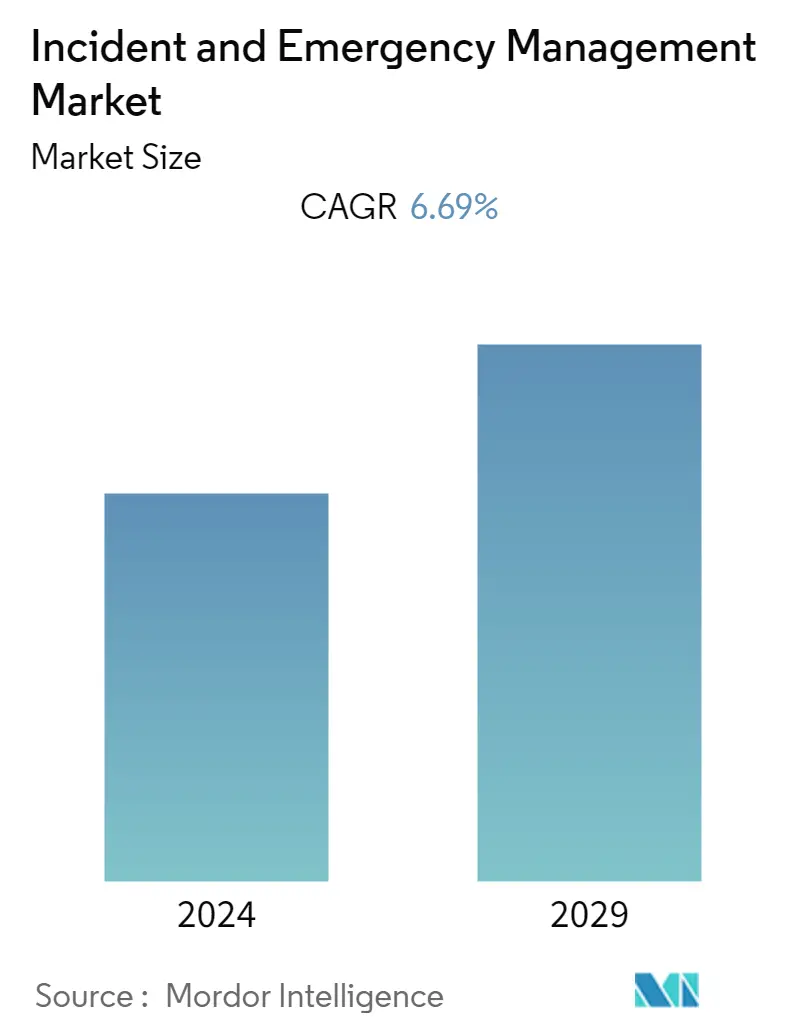Market Size of Incident and Emergency Management Industry

| Study Period | 2019 - 2029 |
| Base Year For Estimation | 2023 |
| CAGR | 6.69 % |
| Fastest Growing Market | Asia Pacific |
| Largest Market | North America |
| Market Concentration | High |
Major Players
*Disclaimer: Major Players sorted in no particular order |
Incident and Emergency Management Market Analysis
The Incident and Emergency Management Market is poised to grow at a CAGR of 6.69% over the next five years. Emergencies are highly unpredictable; it takes intense planning, time, and human resources to recover from crises. The primary factors driving the growth of the studied market include an increase in economic loss from natural disasters and the implementation of governmental policies and regulations to reduce such circumstances.
- Incident and emergency management solutions play a vital role in helping agencies and government bodies to develop effective contingency plans when faced with natural and human-made calamities. For instance, according to Aon plc's 2021 Weather, Climate, and Catastrophe Insight report, a total of USD 343 billion in economic losses occurred in 2021, USD 329 billion of which resulted from weather and climate-related events.
- Additionally, the incident and emergency management market is expanding significantly due to increased natural disasters caused by shifting climatic conditions. Climate change has influenced the prevalence of natural disasters. Climate change can raise the risk of extreme weather and increase the risk of droughts and the increased strength of storms, such as tropical cyclones. The elevated levels of water vapor in the atmosphere give storms the power to emerge.
- According to the World Health Organization (WHO), approximately 1.35 million people succumb to death yearly due to catastrophic road traffic accidents. The WHO also indicates that about 93% of these accidents occur in low- and middle-income countries. Such factors are analyzed to boost the demand for incident and emergency management solutions in low and middle-income countries over the forecast period.
- A study conducted by the National Highway Traffic Safety Administration to understand car accidents critical reasons indicated that reckless drivers cause about 94% of road accidents. Environmental factors, vehicles, and other unknown reasons are responsible for 2% of crashes each. Such statistics highlight the need for better safety measures, thus increasing the demand for incident and emergency management solutions.
- Given the criticality of first responders and public servants' roles, being on the frontlines of responding to an unprecedented public health emergency such as the COVID-19 outbreak has attracted considerable attention toward incident and emergency management systems. Lastly, multiple departments are observed handling calls over the phone to protect first responders. On the other hand, agencies have struggled with keeping workforces productive as more are quarantined at home and protecting officers from handling contaminated evidence.
Incident and Emergency Management Industry Segmentation
Incident and emergency management refer to a standardized approach that prevents and manages incidents or humanitarian emergencies with severe outcomes. It is involved in integrating and deploying emergency systems and solutions at all government and nongovernment platforms.
The Incident and Emergency Management Market is segmented by System (Traffic Management System, Safety Management System, Remote Weather Monitoring System, Emergency/Mass Notification System, Web-based Emergency Management System), Solution (Geospatial Solution, Disaster Recovery Solution, Situational Awareness Solution), Service (Managed Service, Professional Service), End-users (Government, Healthcare, BFSI, Transportation & Logistics, Manufacturing, IT & Telecom) and Geography (North America, Europe, Asia Pacific, Latin America, and Middle East and Africa).
The market sizes and forecasts are provided in terms of value (USD Billion) for all the above segments.
| System | |
| Web-based Emergency Management System | |
| Emergency/Mass Notification System | |
| Traffic Management System | |
| Safety Management System | |
| Disaster Recovery and Backup Systems | |
| Other Systems |
| Solution | |
| Geospatial Solution | |
| Disaster Recovery Solution | |
| Situational Awareness Solution |
| Service | |
| Professional Service | |
| Managed Service |
| End-User | |
| Government | |
| BFSI | |
| Transportation and Logistics | |
| Healthcare | |
| Manufacturing | |
| IT and Telecom | |
| Other End-Users |
| Geography | |||||||
| |||||||
| |||||||
| |||||||
|
Incident and Emergency Management Market Size Summary
The Incident and Emergency Management Market is experiencing significant growth, driven by the increasing frequency and severity of natural disasters and the need for effective contingency planning. The market is expanding due to the rising economic losses from such disasters and the implementation of governmental policies aimed at mitigating these events. The demand for incident and emergency management solutions is further bolstered by the impact of climate change, which has led to more frequent and intense weather-related events. These solutions are crucial for agencies and government bodies to develop robust plans to address both natural and human-made calamities. The market is also seeing increased demand in low and middle-income countries, where road traffic accidents and other emergencies are prevalent, highlighting the need for improved safety measures and response strategies.
North America holds a significant share of the incident and emergency management market, with many global vendors and local governments adopting advanced solutions to protect public assets. The region's high incidence of natural disasters, such as floods and storms, drives the demand for these services. The market is characterized by the presence of established players like IBM, NEC Corporation, and Honeywell, who are leveraging their brand identity and strategic acquisitions to enhance their offerings. Recent acquisitions, such as Hexagon AB's purchase of Qognify and Motorola Solutions' acquisition of Rave Mobile Safety, underscore the ongoing consolidation and innovation within the market. These developments reflect the industry's focus on integrating advanced technologies and solutions to improve emergency response and management capabilities.
Incident and Emergency Management Market Size - Table of Contents
-
1. MARKET INSIGHTS
-
1.1 Market Overview
-
1.2 Industry Attractiveness - Porter's Five Forces Analysis
-
1.2.1 Threat of New Entrants
-
1.2.2 Bargaining Power of Buyers/Consumers
-
1.2.3 Bargaining Power of Suppliers
-
1.2.4 Threat of Substitute Products
-
1.2.5 Intensity of Competitive Rivalry
-
-
1.3 Value Chain Analysis
-
1.4 Assessment of Impact of Covid-19 on the Market
-
-
2. MARKET SEGMENTATION
-
2.1 System
-
2.1.1 Web-based Emergency Management System
-
2.1.2 Emergency/Mass Notification System
-
2.1.3 Traffic Management System
-
2.1.4 Safety Management System
-
2.1.5 Disaster Recovery and Backup Systems
-
2.1.6 Other Systems
-
-
2.2 Solution
-
2.2.1 Geospatial Solution
-
2.2.2 Disaster Recovery Solution
-
2.2.3 Situational Awareness Solution
-
-
2.3 Service
-
2.3.1 Professional Service
-
2.3.2 Managed Service
-
-
2.4 End-User
-
2.4.1 Government
-
2.4.2 BFSI
-
2.4.3 Transportation and Logistics
-
2.4.4 Healthcare
-
2.4.5 Manufacturing
-
2.4.6 IT and Telecom
-
2.4.7 Other End-Users
-
-
2.5 Geography
-
2.5.1 North America
-
2.5.1.1 United States
-
2.5.1.2 Canada
-
-
2.5.2 Europe
-
2.5.2.1 United Kingdom
-
2.5.2.2 Germany
-
2.5.2.3 France
-
2.5.2.4 Rest of Europe
-
-
2.5.3 Asia Pacific
-
2.5.3.1 China
-
2.5.3.2 Japan
-
2.5.3.3 South Korea
-
2.5.3.4 India
-
2.5.3.5 Rest of Asia Pacific
-
-
2.5.4 Rest of the World
-
2.5.4.1 Latin America
-
2.5.4.2 Middle-East and Africa
-
-
-
Incident and Emergency Management Market Size FAQs
What is the current Incident and Emergency Management Market size?
The Incident and Emergency Management Market is projected to register a CAGR of 6.69% during the forecast period (2024-2029)
Who are the key players in Incident and Emergency Management Market?
IBM Corporation, Honeywell International Inc., NEC Corporation, Hexagon AB and The Response Group are the major companies operating in the Incident and Emergency Management Market.

